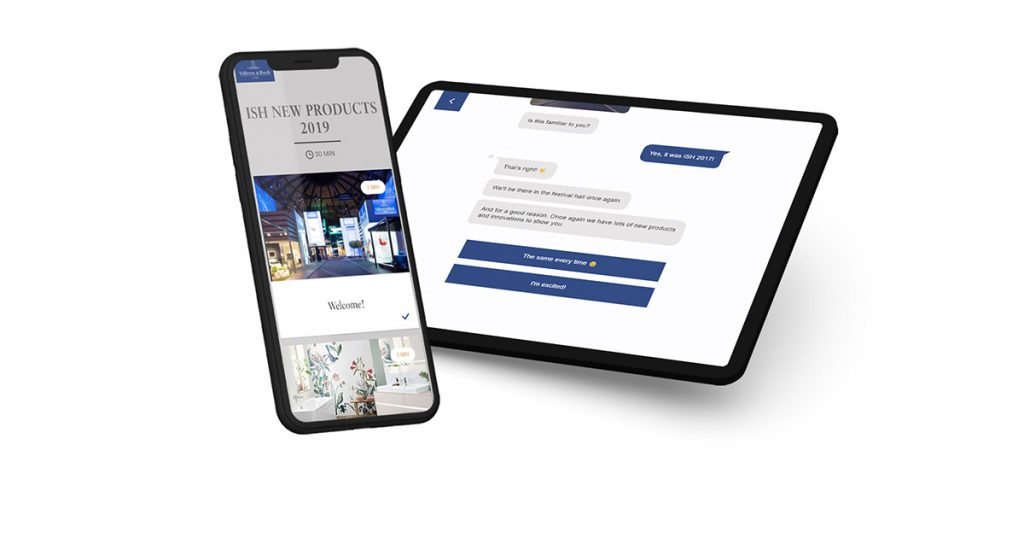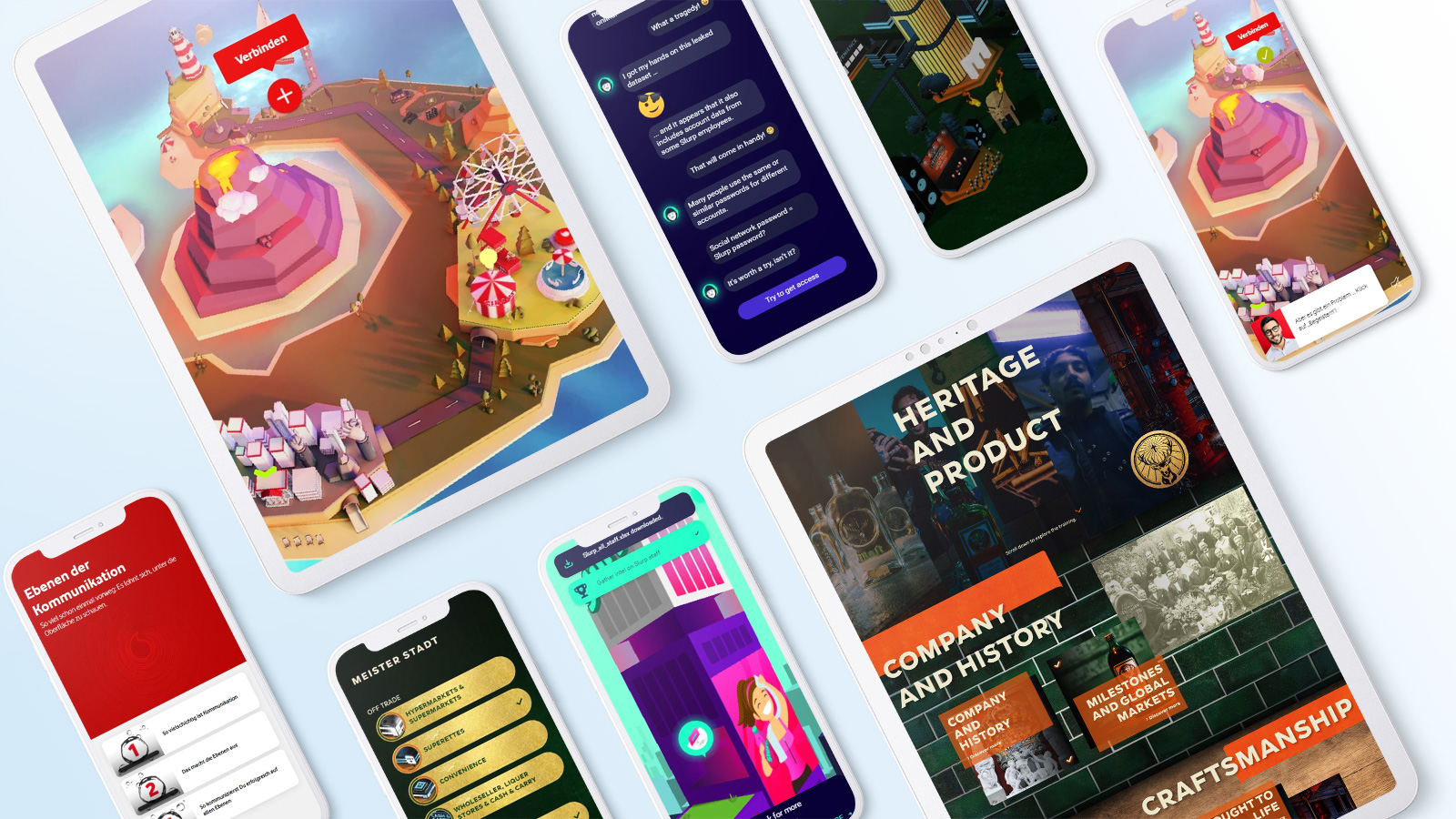
corporate learning
10 proven ways to keep corporate learning engaging
Rolling out certain types of learning content can sometimes cause L&D or IT managers to cringe. This is especially likely when technical content focuses on dry subject matter or tick-box compliance exercises that aren't always directly related to the learner's role.

Top 10 tips for HR heads, IT security, and L&D professionals to foster active learning
Technical training topics, such as cybersecurity awareness training or learning a new software system, are often essential for employees to acquire the necessary skills and knowledge to be productive or to comply with legal/regulatory requirements. However, these topics are often considered dry and boring due to complexity, specialised language, or seemingly distant relevance to everyday work life.
The 10 ways to keep corporate learning engaging set out below make the learning process more enjoyable and effective.
1. Relate to real-life scenarios
Learners are more likely to engage with technical topics if they can see the direct relevance to their lives or careers. Present real-life scenarios, case studies, or anecdotes that demonstrate how the technical concepts are applied in practice. This will help learners understand the importance of mastering these topics and make the material more relatable.
2. Break down complex concepts
Technical topics can be intimidating due to their complexity. Break down the concepts into smaller, digestible parts, and provide clear explanations and examples for each. Use analogies, metaphors, or comparisons that learners can easily understand to explain difficult concepts. Additionally, create a logical progression of information, building on what learners have already grasped.
3. Use multimedia resources
Leverage various multimedia resources, such as videos, audio recordings, graphics, and animations, to illustrate technical concepts. These resources can help make the material more engaging and accessible, as well as cater to different learning styles. Additionally, incorporating multimedia resources can reinforce key concepts and provide alternative ways for learners to process information.
4. Encourage active learning
Active learning techniques, such as group discussions, problem-solving exercises, and hands-on activities, can make technical training more engaging. By actively participating in the learning process, learners can better internalise and retain the material. Encourage learners to ask questions, share their perspectives, and collaborate on projects to create a more interactive learning environment.
5. Gamify the learning experience
Gamification can make dry technical training topics more enjoyable and motivating. Introduce game elements, such as point systems, leaderboards, and badges, to create a competitive atmosphere and drive engagement. Additionally, design interactive quizzes, puzzles, or simulations that require learners to apply their knowledge in a fun and challenging way. As an example, we turned one of the driest topics of all - cybersecurity training - into a fun, interactive game - Cyber Crime Time.

In this gamified learning experience, you take the role of a devious hacker. By exploring IT security from the hacker's perspective, learners gain new levels of cybercrime awareness without the process feeling like 'training'.
Try out the game for free to learn about this innovative approach to technical training.
6. Provide immediate feedback
Timely feedback is crucial for learners to understand their progress and identify areas for improvement. Provide immediate feedback during training sessions, either through automated systems or personal interaction. This will help learners adjust their learning strategies and stay motivated.
7. Foster a supportive learning environment
A supportive learning environment can help learners feel comfortable asking questions and discussing technical topics. Encourage open communication and create a culture of mutual respect and understanding. Instructors should be approachable, patient, and willing to provide assistance as needed.
8. Set clear goals and expectations
Learners are more likely to engage with technical training if they understand the goals and expectations. Clearly communicate the learning objectives, expectations, and assessment criteria at the beginning of the training. This will help learners focus on the most important aspects of the material and track their progress.
9. Offer flexibility and customisation
Allow learners to customise their learning experience based on their needs, interests, and learning styles. Offer flexible pacing, optional supplementary materials, and various learning pathways to accommodate individual preferences. This will help learners feel more in control of their learning experience and increase their motivation to engage with the material.
10. Incorporate peer-to-peer knowledge sharing
While some technical training will often need to be formally structured to ensure precision or regulatory compliance, there is often space for informal, peer-to-peer knowledge sharing.
Does your new software system have a 'power user' in the company? Or does one of your team have a way of communicating and sharing knowledge that’s particularly funny or engaging.
Some new e-learning authoring tools, like our own imc Express, are emerging that make it quick and easy to create and share multimedia learning nuggets in as little as 10 minutes. This can enable subject matter experts to become a useful addition to the L&D team - albeit unofficially. It also helps to avoid valuable knowledge and experience to be siloed within departments - or even worse, lost altogether if key personnel were to leave the company.
How to get started
Engaging learners with dry technical training topics may be challenging, but it is achievable if you implement some or all of the above 10 ways to keep corporate learning engaging. By relating the material to real-life scenarios, breaking down complex concepts, using multimedia resources, and fostering active learning, L&D or IT leaders can create a more engaging and effective learning experience for their learners.
With the right approach, even the driest technical topics can become engaging - maybe even fun! 🙂
Want to learn more about tools and strategies to make technical training more engaging and effective? Get in touch - we'd love to hear from you!

workforce
Training diverse and disparate workforces
Here at imc Learning, we have decades of experience helping customers train hybrid workforces - diverse and disparate learners at global companies. In this post, we cover some of the essential tools and strategies for L&D leaders to consider when training a hybrid workforce.
We also look at how the best e-learning solutions make creating, delivering and analysing your training easier than ever - wherever your employees are based, and whatever language they speak.

Look back a decade, and early proponents of remote work, such as Basecamp, were seen as unusual - even maverick. Today, post-Covid-19 pandemic, some level of remote or hybrid work is standard for large organisations.
What can vary considerably between large organisations though is the quality of training to hybrid or remote workers and the level to which they are kept engaged and in the loop.
Checklist for training hybrid/remote workers
Many of the points here might seem obvious, but whether you are an experienced L&D leader or relatively new to training remote teams, it can be easy to see certain elements of employee engagement as a given and forget to carry them out. Unfortunately, out of sight can really be out of mind all too often, and this can lead to a feeling of isolation and disengagement among remote workers.
Below is a checklist to help you ensure you don’t miss out any of the steps needed to create a comprehensive training programme for your hybrid workforce
Assess your training needs
Before you can create a training program, you need to understand your unique needs. Consider the following to train your hybrid workforce:
- Job roles: Identify the skills and knowledge required for each job role.
- Skill gaps: Determine the skills that need improvement or development.
- Technical requirements: Evaluate the tools and technology needed to support remote and onsite employees.
Set clear objectives and goals
Establish specific, measurable, achievable, relevant, and time-bound (SMART) objectives for your training program. These objectives should align with your company's overall goals and focus on addressing the skill gaps identified earlier.
Choose the right training formats
To accommodate both remote and onsite employees, consider using a mix of training formats, such as:
- E-learning: Offer self-paced online courses and tutorials.
- Webinars: Conduct live or pre-recorded sessions for real-time interaction.
- Instructor-led training: Provide in-person or virtual classes led by experienced trainers.
- Blended learning: Combine multiple training formats for a more comprehensive learning experience.
Develop engaging training content
Create high-quality, engaging training content that caters to different learning styles. Ensure your materials are up-to-date and relevant to your employees' roles. Consider incorporating interactive elements like quizzes and gamification to boost engagement.
Leverage e-learning technology
Use various technology tools to support your training program, such as:
- Learning management systems (LMS): Use an LMS to organise, distribute, and track training progress. The imc Learning Suite integrates with many other HR and business software applications, and offers powerful training delivery and learner analytics tools.
- Video conferencing: Integrate video conferencing tools, such as Zoom, Google Meet or Microsoft Teams to facilitate virtual instructor-led training and webinars.
- Collaboration tools: Encourage teamwork and collaboration among remote and onsite employees through platforms like Slack or Microsoft Teams.
Implement a support system
- Mentorship programmes: Pair employees with experienced team members for guidance and support.
- Online forums: Create a space where employees can ask questions and share knowledge.
- Regular check-ins: Schedule periodic check-ins with employees to monitor progress and address any concerns.
- Peer-to-peer knowledge sharing. imc Express is an e-learning authoring tool that makes it easy for your subject matter experts to create and share engaging learning modules in as little as 10 minutes, with no design or coding expertise needed.
Evaluate and recalibrate your training programme
Regularly assess the effectiveness of your training programme by gathering feedback from employees and analysing performance metrics. Use this information to make any necessary adjustments to your training content, format, or delivery methods.
How to get started
Learning how to train a hybrid workforce requires a thoughtful and flexible approach. Often you will need to accommodate the needs of both remote and onsite employees. By following this checklist and leveraging the latest tech, you'll be able to create a comprehensive and effective training programme that supports the success of your entire workforce.
Would you like to discuss how our suite of e-learning solutions can support your hybrid workforce? Get in touch - we'd love to hear from you!

training for retail
Transforming retail training
with e-learning
The retail sector is a dynamic and rapidly changing environment. Advancing technologies, intense competition, and evolving consumer demands, all drive transformation. Training employees to stay ahead of these changes is critical to the success of any retailer.
For decades, we’ve helped some of the world’s biggest brands to maximise their retail training ROI. Here we look at the unique challenges faced by the retail sector and how great e-learning can help overcome these challenges.
Unique training challenges in the retail sector
- High employee turnover: The retail sector is notorious for high employee turnover rates. The average retail employee turnover is 60.5% in the US and 57.3% in the UK. This makes it essential for retailers to invest in training for new hires, but also to engage and retain your best existing employees.
- Seasonal workforce: Retailers often employ a large number of temporary or seasonal workers, who require quick and efficient training to perform their roles effectively.
- Diverse workforce: Retail employees come from various backgrounds and possess varying levels of skills and experience, making it challenging to develop and deliver consistent training that feels relevant to your learners.
- Dispersed workforce: Retail companies often operate across multiple locations, making it difficult to coordinate and deliver in-person training.
- Rapid technological advancements: The integration of new technologies, such as e-commerce, mobile payments, and inventory management systems, requires retailers to continually upskill their workforce.

Why e-learning is great for retailers
- Cost-Effectiveness: E-learning platforms can significantly reduce the costs associated with traditional training methods, such as travel, accommodation, and printed materials. This allows retailers to maximise their training budgets and allocate resources more effectively.
- Flexibility and Scalability: E-learning provides retail employees with the flexibility to access training materials anytime, anywhere. This enables employees to learn at their own pace and schedule, leading to higher engagement and completion rates. Furthermore, robust e-learning platforms can be easily scaled to accommodate a growing workforce or the introduction of new technologies.
- Personalisation: E-learning platforms can be customised to create personalised learning paths, catering to the individual needs of retail employees. This ensures that each employee receives training that is relevant to their job role and helps them fill their skill gaps. Such learning personalisation can help employees to feel valued and increase staff retention levels.
- Consistency and Compliance: E-learning platforms ensure that all employees receive the same training content, promoting consistency across the organisation. Moreover, they can be updated quickly to reflect changes in regulations or company policies, keeping employees up-to-date with the latest requirements.
- Analytics and Performance Tracking: The best e-learning platforms, such as the imc Learning Suite, provide detailed analytics on employee performance, enabling retailers to track progress, identify areas that require improvement, and provide targeted support.
- Engaging and Interactive Content: E-learning platforms offer a variety of multimedia content, such as videos, quizzes, and simulations, making the learning experience more engaging and enjoyable for retail employees. Easy to use e-learning authoring tools like imc Express can allow your own subject matter experts to create engaging e-learning as and when needed to share with colleagues - without the need for design or technical experience.
Retail e-learning examples
How to get started
E-learning presents retailers with a powerful tool to address the unique training challenges they face, such as fast-changing product lines and high employee turnover. By leveraging the benefits of modern e-learning, retailers can continually upskill their workforce, ensure training consistency, and foster a culture of continuous learning.
The result is an engaged, skilled, knowledgeable workforce that’s ready to tackle the challenges of a competitive retail landscape.
Are you involved in retail L&D and want to learn more about how the best in modern e-learning can support your training? Get in touch - we'd love to hear from you!

Leadership Training: When the Boss Takes the Learner’s Seat
Improving leadership ability through effective training
Our perceptions and expectations of leadership personnel have changed a lot in recent years. Today’s managers are expected to have both subject expertise and good people skills. Subject expertise can be learned, obviously, but what about the people stuff – the soft skills?
Managers are expected to be able to see things from the employee’s perspective and respond appropriately. The requirements go far beyond merely delegating projects and issuing instructions. The usual hard skills need to be tempered with empathy and judgement in dealings with staff. And that’s where our experts can help – by designing leadership training courses.


Kathrin Heidler, Instructional Designer at imc
Kathrin Heidler has a degree in education, with a major in digital learning. Since 2020 she’s been an educational designer at imc, designing digital learning formats, blended learning strategies and web-based training courses. And she has a strong focus on leadership training. “For me, leadership means empathy for staff, backing your team – both internally and externally – and having technical expertise,” she says. “These are all things you can train for – the hard skills, obviously, but the social skills too. What I find exciting is to dive deep into the ‘how’ of that.”
“Leadership training” is not the same thing as “management training”
Heidler explains that at imc, leadership training means focusing on and learning the core competencies of effective leadership. It relates exclusively to non-technical skills, like communication, empathy, organisational and methodological competencies, and other soft skills.
Management training, on the other hand, relates to learning about new products, specific processes or strategies. It’s about acquiring knowledge and technical – or “hard” – skills.
Both types of training can be combined, of course, but they are generally intended for two different target groups:
- Employees new to leadership roles who need to learn the necessary people skills and understand their company’s mission.
- Employees already in leadership roles who need to learn new strategies or acquire new technical knowledge at the managerial level.

However, in both cases, the leaders concerned are generally time poor when it comes to learning. “Leadership personnel are always on a tight schedule, and time is always a big challenge for them,” Heider explains. “That’s why it’s vital to be efficient and find out in advance exactly who needs to do what training. This is especially true for management training courses.
In these cases, I like to work with our KPI-based Readiness Check. It allows me to gauge each learner’s existing knowledge level so that I can suggest appropriate content and learning options. That saves a lot of time and frustration.”
Success hinges on having clear parameters and expectations heading into these courses. “Both parties must have a realistic understanding of the basic requirements and constraints. And by both parties, I mean the company seeking leadership training, and us as their strategic partner,” Heidler explains. “What’s to be learned, and how? Realistically, how much time is available for the leadership training? Only by having clear objectives can we achieve successful training outcomes.”

“Effective course design is about getting from the aspirational to the factual”
Katrin Heidler has already supported numerous customers as a strategic sparring partner for the design of leadership training courses.
“Given all the hype around leadership and management training, I make a point of focusing the client on the basics,” she explains. “So, at the start, we stay very analytical and nail down things like exactly who the target group is. What defines the group? What is the learning objective? What specific actions and behaviours is the course supposed to teach?
“It’s not enough to simply say, I want to make the managers more agile. I have to be able to specify exactly what actions constitute agile behaviour. Breaking it down to specific actions enables the courses we design to achieve the desired outcome of better leadership ability.”
When designing leadership training, start by writing a list of core competencies and mapping those to specific types of action. This will provide clarity around what’s expected of the training because it provides a bridge from aspiration to facts and actions.
Choosing the right learning formats
Modular learning nuggets:
learners can complete a training session in just 10-15 minutes
Performance cards as digital flashcards:
Learning content can be presented in a short and punchy way
Virtual classrooms:
Time is blocked out directly in the learner’s calendar; this format does, however, require a trainer
Hot curriculum picks for leadership training
In closing, we asked Kathrin Heidler to give us her picks for learning objectives for leadership training in 2023:
“Leaders need to be aware that we’re in a time of economic and demographic change. And they need to be confident and sure – not fearful – in dealing with this change. They should continue to work on their own technical skills. Last but not least, they need to see their staff as people, with all the needs that being human entails. That would be my learning recommendation.”

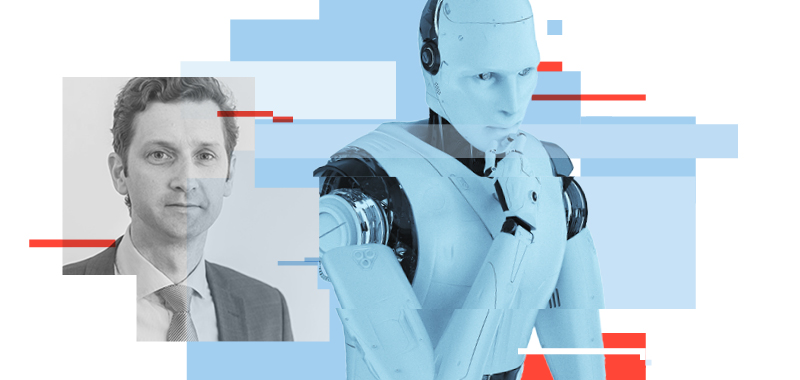
Can Germany afford its current AI scepticism?
Artificial intelligence (AI) is often viewed sceptically in Germany, but often without justification. In this interview with Kristian Schalter, we talk about how future technologies will change our working world.

AI in Corporate Learning
There are many fears about the topic of artificial intelligence (AI). But especially in corporate learning, AI can be a great help.
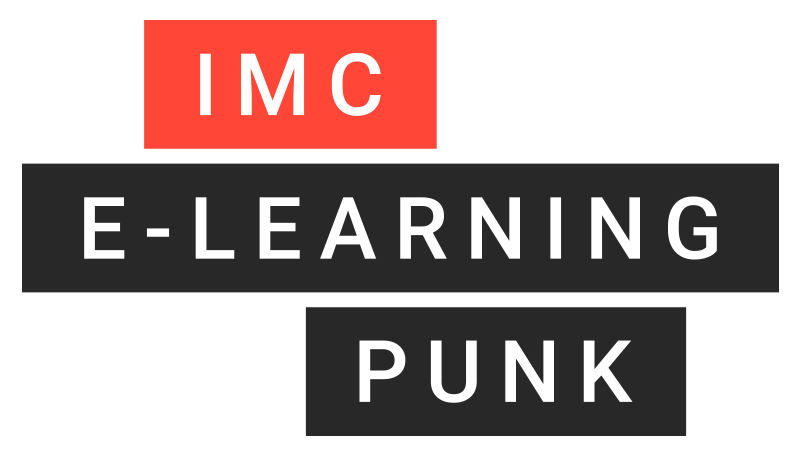
Contact person
I joined the imc newsroom team in 2021. As a journalist my heart beats for content and storytelling.
I’m excited to figure out how e-learing and digitization affect the future of work. My task is to create content to talk about and I’m always looking for trends.
Privately I love to travel and eat Tapas.
Topics: E-Learning Trends, Corporate Social Responsibility, Press and Influencer Relations

Equality and new work concepts as a formula for success
Stepping out of the comfort zone – Wine-growing entrepreneurs, part-time managers and working dads
On 8th March we celebrate International Women’s Day. This year’s focus is: Equal opportunities and equality of women and men. As in previous years, a large variety of events, forums and discussion groups are held under the hashtag #EmbraceEquity. Given our experiences during the corona pandemic, we at imc already asked ourselves last year, whether the crises undid decades of progress on the path to gender equality. As part of a roundtable discussion that included many external guests, we looked at the topic of “Women in the Hybrid Working World”. This generated a wealth of new and thought-provoking ideas. We wanted to know what has changed since last year, and how equality is realised. So, we asked our Executive Board and our colleagues.

Part-time manager: Career with time for family
The return from maternity leave did not go according to plan. Lockdown made the envisioned full-time role impossible, as Sabine Sauer and her husband faced challenges many other couples were only too familiar with. They needed to balance two 40-hour working weeks with childcare. Sabine decided to reduce her hours in her sales role at imc. Her employer’s reaction was a thoroughly positive experience: “It was very straightforward. As a woman, I was given the opportunity to do a cool job without the full-time commitment.”
When talking to Sabine, it is obvious that she loves her job. “Improving processes and driving communication between departments is extremely important to me.” A few weeks ago, she was promoted to Head of Account Management. This came completely unexpected for her. “I think it’s really cool that my employer trusts me to handle this role even though I don’t work full time. There would be no chance of that happening at other companies.”
However, reactions to her promotions were often more reserved in her private circle. She would hear comments such as “How are you going to manage?” or “Is that not a bit much for you?”. The sportsmanship of the former marathon runner and triathlete shines through in how she handles these doubts. “You only improve when you step out of the comfort zone.” Sabine has learned to push through and encourages other women: “You will achieve a lot with good organisation and structure.”

Equity means for Sabine to do the same things without restrictions.
Working dad: Co-parenting as a family model
In recent years, a thorough change has become apparent among many fathers. They are no longer satisfied with being a weekend or leisure dad. Fathers now value family time as an important asset. Kenneth Littlepage – aka Kenny – is the proud dad of a 2-year old daughter. He made a conscious decision for parental leave. “There are various ways you can plan parental leave. We opted for a hybrid version, where I would work three days a week and my wife would work two.”
Kenny highlights that this model not only strengthened his relationship with his daughter, but also that with his wife. Both him and his wife would look after their daughter, handle the household chores and take responsibility for everything else on the days the other party was at work. Neither was exempted from any particular task. This helped him experience his child in a totally different way as a father. He also had to learn that everyday life is difficult to plan with a child, and some flexibility is always required.
He is very thankful that his employer offers flexibility and praises the new hybrid work model that imc introduced after the pandemic. “You can decide whether you want to work in the office or from home. That puts me and my wife on an equal footing. We have the same opportunity to coordinate our schedules and support each other.”

Equity means for Kenny to be fair and impartial.
Between the office and vineyards: 2 jobs, 100% satisfaction
Simone Weber, Instructional Designer at imc, can confirm that equality extends far beyond the family context. About ten years ago, she took over her parents’ winegrowing business, cultivating the six-hectare vineyard together with her husband – on the side. Simone loves her work on the vineyards, which offers her a perfect balance to the “brain-work” at imc.
Leading a 20-member Instructional Design team, her days are filled with appointments and consultations. The vine is at the other end of the scale. “I am outside, all by myself. I listen to audio books or podcasts. Nobody speaks to me. It is really quite meditative.”
Simone appreciates the flexibility offered, but also wants to give something in return: “The grape harvest starts on a different date each year. I can take a 2-week holiday at the right time, whether that is in September or in October. My employer has always been accommodating in that regard. I will say though, that I am also willing to be flexible. If a meeting requires me to be on location, I don’t mind staying a little longer. There are times where you give, and times where you receive. I believe you need to maintain a balance – and that works quite well at imc.”

Equity means for Simone to maintain a balance.
Self-reflection at the core of the imc diversity programmes
Equality and fairness – at imc, these two topics are not reserved for International Women’s Day.
Kerstin Steffen, Director Brand Strategy, has been heading the empowerHer Programme for almost four years, supporting women and young talents. She experienced many different aspects in her own career, both highs and lows. This is why fairness is so important to her now: ““Fairness means that we need to get rid of personal, unreflected prejudices and judgments, and biased, preferential treatment in order to create a fair and equitable world. Each and every one of us can actively support that within their own sphere of influence.”
Sven R. Becker, Member of the imc Executive Board, also emphasises that a holistic view of equality is necessary, and that it cannot be reduced to gender alone. “We need to look at a bigger picture of equality. It encompasses a variety in opinion, in work practices and much more. The most important thing is to self-reflect on everything you say,” he concludes. “In the end, it is people – not measures – who make diversity and inclusion thrive in a company.”
Thus, all of the company’s diversity programmes – from female leadership to inclusion – have self-reflection at their very core. Sven R. Becker aims to set a good example at all times. “I try to pay attention to my own words, and the effect those words have. And that is what I would like to see in others.”

Members of the imc Diversity Movement Gather to Celebrate Successful Year
In order to establish diversity and inclusion as broadly as possible in our organisation, we launched a D&I programme – a programme organised by our employees, for our employees.

Diversity and Inclusion at imc: How We Are Continuing to Walk the Talk
Diversity and inclusion is now an integral part of our corporate culture here at imc. Our workdays are generally pretty busy, obviously, but we will always find the time to champion this important issue and generate awareness of our initiatives.
Contact person
I've been part of the Marketing & Communication team at imc since 2014. My hear beats for creative campaigns, exiting content and digital innovations. My goal is to make digitization tangible - understandable and simple to the point. My passion besides my job are good books and sports. I'm always happy to receive feedback at [email protected].


The crazy tech guy who wanted to be a Formula 1 driver
Meet Ravi Tandon, Customer Success Manager at imc Australia
Formula 1 and learning management systems don’t really have much in common. But if you want to be a pro in either of them, you need a lot of passion. And that’s definitely something Ravi Tandon, a customer success manager at imc Australia, has in abundance.
I’ve probably never spoken to any imc employee who is as passionate about the product they’re responsible for as Ravi. But then Ravi is, as he freely admits, quite a crazy guy, who still regrets the fact that he never got to be a Formula 1 driver. In this interview, he talks about his tasks, why he made the LMS his girlfriend, and a job interview that featured some very tricky questions.

Ravi Tandon
Job | Customer Success Manager
Works in | Melbourne, Australia
With imc since | 2015
Superpower | Making customers happy
Favourite food | Dosa from India

Hi Ravi, great to meet you! How would you explain to your parents what you do as a customer success manager in e-learning?
I’d tell them that I make our customers happy, that I make sure they don’t feel like just another number. It’s my job to ensure our customers know they made the right choice with imc.
That sounds like a very important role. What does it involve exactly?
You know, my role is actually a mix of customer success manager and e-learning consultant, and indeed I feel this is a very critical role for the company. Because here in Australia these roles are not so strictly separated from each other as in Germany, for example.
So, I take care of all issues that our customers have with our learning management system (LMS) and make sure they feel comfortable with our service and our product. But that’s not all. It’s also part of my job to ensure they trust and believe in us as a capable team.
Our tagline is “we empower”. And that’s what I try to do: I aim to empower customers to work as effectively as possible with our product. My goal is to find the best business solutions for them. Moreover, I want to make talking to us a positive experience for them, and, as I said earlier, make sure they don’t feel like just another number.
So, you need an in-depth knowledge of our LMS, the imc Learning Suite, but you haven’t been working with the LMS the whole time you’ve been with imc? Is that right?
That’s correct. My career path at imc is quite unusual. I started in pre-sales for our LMS, but then worked in the content team for a while. It was a great time, and I learned a lot, but I feel that I’m more of a tech guy. I love our LMS, and that is where I belong.
But one thing that all my roles at imc had in common was a great sense of exciting complexity. In the content team, the approach was rather top down, but the process was highly creative. In the LMS team, you work with a lot of different departments and people in various roles. That can be challenging and involve a lot of back and forth, but I love interacting with different people and in different ways.

What do you like most about your job?
I just love our system. For me, the LMS is like a black hole – and I mean that in an absolutely positive way. It’s so wonderfully complex, and you’re always finding new functions, or new ways to use certain functions. It’s like navigating in a spaceship in outer space, and I’m the navigator – for our customers.
It just feels good when a customer calls you – perhaps they’re desperate, or annoyed with something – and I can help them out. I enjoy that feeling of confidence and being a subject matter expert with the ability to turn an unhappy customer into a happy one within the space of a single phone call.
But I have to give big credits here to the team in Germany. At the beginning, they taught me a lot about the system, and they still have so much detailed knowledge that they’re always happy to share.
Which skills do you think are the most important for your current job?
From my point of view, technical understanding and knowing the product very well are the most important things. Then again, it also helps if you’re good with people and have a sense of humour. Because in the end we’re all humans, and everyone feels better talking to someone who can make them laugh.

How did you come to imc, and where did you work before?
I’m originally from India, but I lived and worked for many years in the USA. When the e-learning company I was working for closed, I applied for a visa for Australia. I just didn’t want to go back to India, plus Australia seemed like an interesting country. When I finally arrived here, I had nothing. No apartment, no friends, no job.
Then I saw the job at imc, and it just fitted perfectly. So, I applied, got it, and spent the first three months in my new country making the imc LMS my new girlfriend. I wanted to learn as much about the system as possible and really get a deep understanding. So, I did a lot of self-learning, including in the evenings and on the weekends.

I heard your job interview was rather funny. What happened?
Oh yes, that’s a great story. As I said, I had worked in e-learning before and had 15 years of work experience. Anyway, when I was interviewed, it was a panel including a German-speaking colleague.
First, he asked some basic questions about me – my attitude and things like that. But then he wanted to test me, so he gave me some more challenging questions. Well, I was able to answer all of them. I challenged him back and told him to give me harder questions, but I was able to answer all of those, too.
Finally, he gave me a mischievous grin and said: “Ok, now I will give you one question, and I guarantee you will not be able to answer it.” I told him to go ahead but was still optimistic. Well, he asked me a question in German – which, obviously, I couldn’t answer as I don’t speak German. It was hilarious!
What makes working at imc special compared to other companies?
I’ve only worked for three other companies before. And the big advantage here is that you get a lot of freedom to work towards making customers happy. But the most important thing for me is the product because the engineering behind it is just awesome.
I’ve worked with 14 learning management systems in the past, and know a lot of other products, but I’ve never seen a more sophisticated and powerful system.

Ok, and now for a few short, random questions. Please complete: When dealing with colleagues, it is especially important to me...
… to see passion. I’m very passionate about our product and my job, and I expect others to do their job with the same passion. I don’t like it when people just have a nine-to-five mindset. I want to see them solving customers’ problems and really diving into the topic.
Which department would you like to visit for a week?
Marketing, because I guess in all other departments I would know what to expect. But honestly, I have no idea what Marketing does. I think it’s rather complex, and there is much more going on behind the scenes than you see. So, I would like to learn more about that and also about how they go about making people happy.
If you could travel back in time, would you choose the same career path again?
No, I wouldn’t. If I had grown up in the right environment, I would have become a Formula 1 driver.
[Editor’s note: Having been co-driving with Ravi, I can say it’s probably a good thing he never became a Formula 1 driver].

Name something that drives you up the wall?
People who are not doing their job. Because when I look at myself, I feel that I do much more than I should. But sometimes people put their own interests ahead of those of the company. That’s not my way.
What’s your favourite movie?
Scarface: “I always tell the truth, even when I lie.”
How much coffee do you drink?
Before coming to Melbourne, I wasn’t big into coffee at all, but now I drink two to three cups a day.
What are your hopes for the future?
I would like to represent imc in the American market and become the most successful consultant in the USA.
And I'm sure you would do a great job there as well! Thank you very much for these great insights and all the best, whatever your next steps at imc will be!

A Fine Line Between Genius and Madness: A Day in the Life of an IT- System Administrator
Q: What do you get if you combine technical savvy with the patience of a saint and a willingness to help? A: The perfect system administrator. In other words, someone like Raffael Willems, Head of Internal IT at imc.

Teamwork makes the team work: A Technical Consultant debunks the myth of the Hermit Techi
A Technical Consultant debunks the myth of the Hermit Techi and explains why he ones worked in "car-office".
Would you like to know more about imc as an employer? Then take a look at our career section, maybe there is a suitable position for you.
We are also always happy to receive unsolicited applications!

Contact person
I have been working in the Marketing & Communication Team at imc since March 2019.
Communication, creating unique content and social media are my passion.
"One can not not communicate" - Paul Watzlawik.
To explain complex content in an understandable way and thus make the topic of e-Learning accessible to everyone is an exciting challenge every day.
Privately I love to read, play poker and travel a lot.
I am always happy to receive feedback or suggestions.
Best of 2022: Milestones of the New Work Transformation at imc
Taking stock after 12 months of New Work
New Work. It’s been the talk of the business world in recent months, and that’s certainly true here at imc. Not that we were ever happy just to leave it at words. So, a year ago exactly we decided to turn our working world on its head and try something new.
Our New Work model would be 100 percent flexible – but not 100 percent remote. Our goals were specific, our aims high, and our motivation strong. Since then, there have been new benefits, new structures and changes aplenty. But what could we do better? What else needs to be done? And what do our employees think? Let’s take a look at the highlights and see what we can learn from the year that was.

New Work one year on – Our verdict
Quite a lot has changed for us after a year of hybrid working. We’ve gone 100 percent flexible but not 100 percent remote – while staying true to our corporate goals, as intended. There have been other changes too, such as our new workation model, a new onboarding programme and new offices. And the feedback from our employees shows we’ve taken the right approach and the transformation is meeting with approval. But what’s the verdict from the company’s point of view?
Christian Wachter, Chair of the Executive Board of imc, shares his take: “For us as imc, the New Work transformation has been a major step in the right direction. Employees and job applicants alike definitely see it as a plus. Our new structures and work philosophy provide an up-to-date, flexible way of responding to today’s challenges and needs and providing an attractive working environment. And we’ve done that in a way that allows us to stay on track with our corporate objectives.”

But all the positives aside, the introduction of New Work is by no means a guaranteed success. It requires active, collaborative design, as Elke Zastrau, Head of Human Resources and member of the New Work Transformation team, explains.
“For us, New Work is an ongoing transformation process that’s all the more challenging because there are no role models that are 100 percent transferable. Also, certain general challenges are more difficult in a hybrid context. Hence, on the transformation team we’re looking at how our leaders shape aspects like individual recognition, identification, interaction, and inclusion. We’re also paying particular attention to issues relating to productivity, results focus and innovativeness at imc.”
So, what milestones have we achieved in 12 months of New Work? Let’s take a closer look and reflect on the highlights.
Welcome on board – Our new onboarding journey
Our new onboarding programme has been a major hit – with existing staff as well as new hires. That’s because, with our transformation under way, the time was also right to rethink our old onboarding journey. Alongside global processes, we wanted to create a harmonised journey that did more than merely inspire and motivate new staff. It had to communicate our brand and all its associated values as well. It was also important to take a hybrid approach because, our love of digitalisation aside, we know that communication has to be human. Accordingly, the journey could not be purely digital. It had to include face-to-face meet-ups with staff at the office as well. Needless to say, there had to be room for fun and entertainment, too. And we’re very pleased with the results.
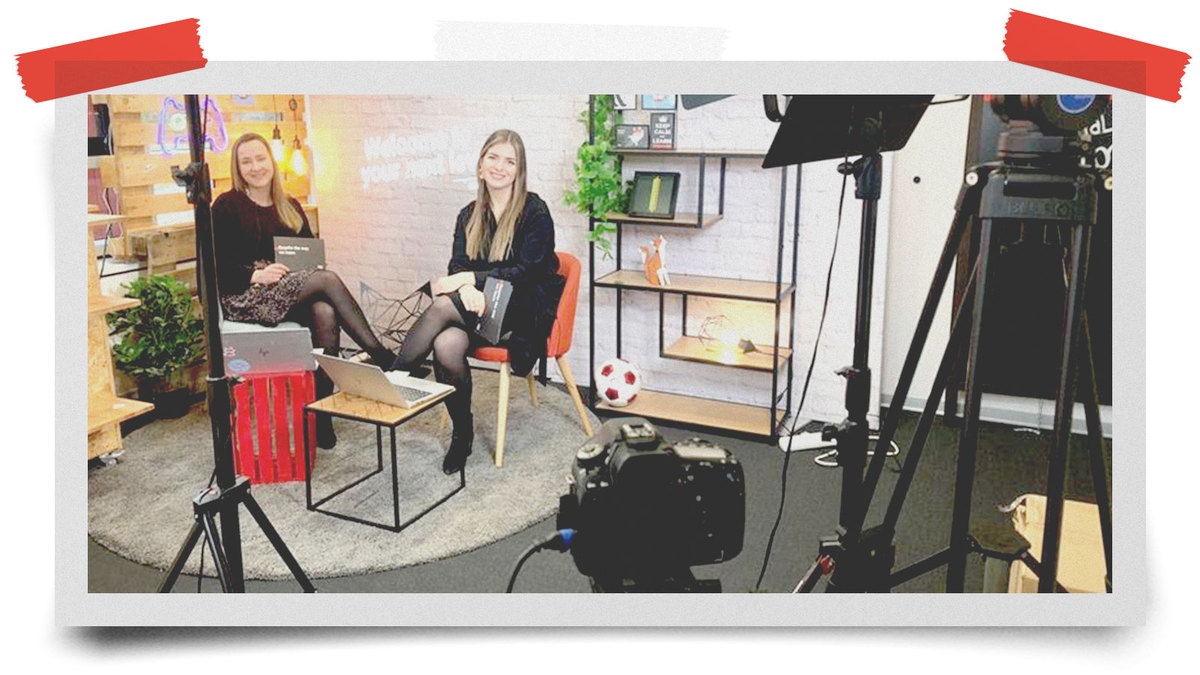
New from old – Our new workspaces
The aim of our new office concepts was to create even more scope for individual development and creativity. This was important because our workforce is highly diverse, with highly diverse needs. So, we set about giving our offices a new look on a small budget, with just a few simple tweaks. We wanted offices that were functional and versatile yet inviting. Spaces that were global in design, but with unique local character. The result? Modern workspaces that are flexible, enhance efficiency and create a pleasant working environment.
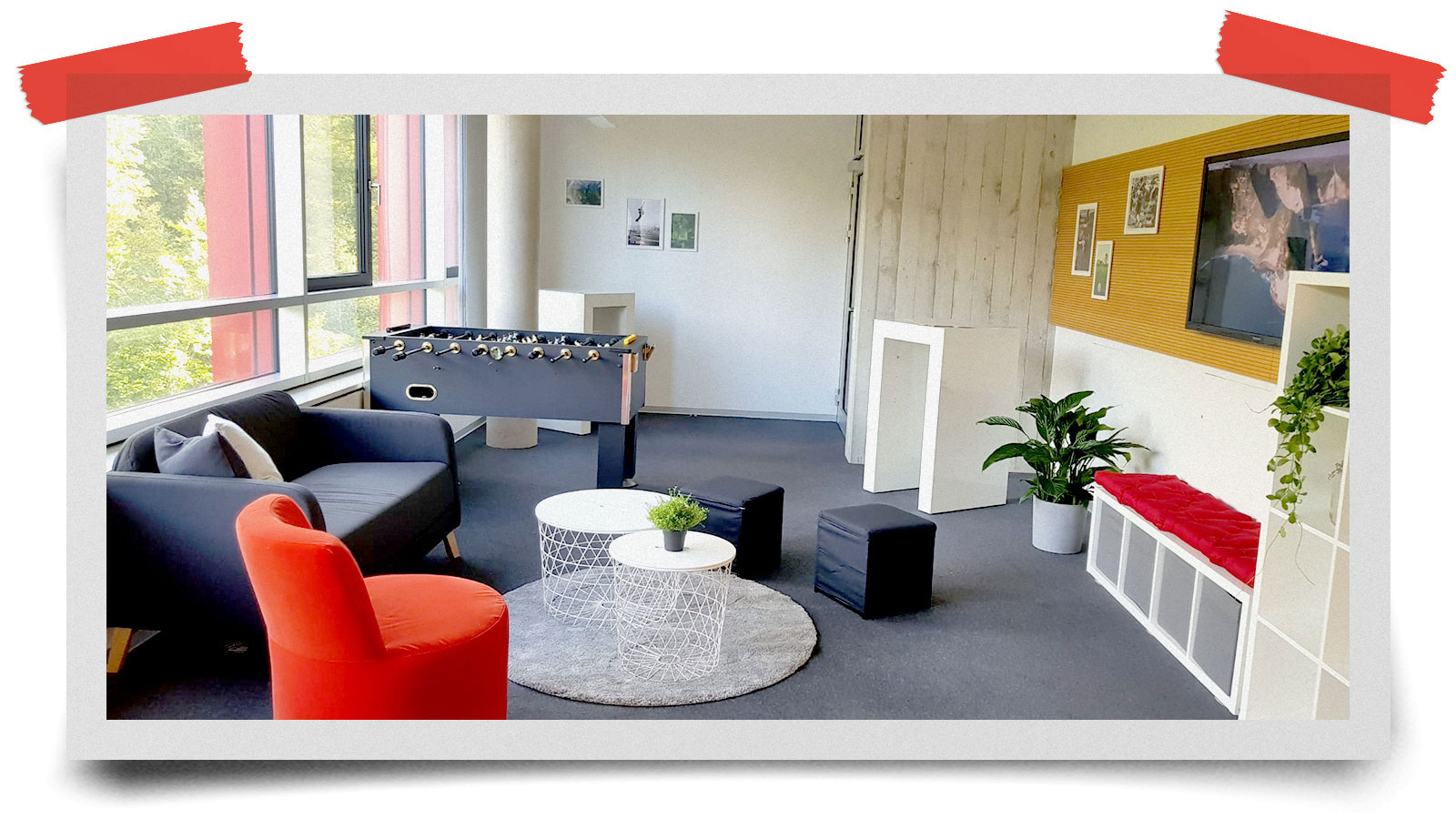
Rethinking communication and collaboration
With hybrid working, the focus of our daily meetings has shifted away from the office and into the virtual world. But we want to make sure that’s not at the expense of effective collaboration. That’s why we’ve produced global communication guidelines and event formats – to break down internal structures and redefine work practices. Our individual locations, too, are working hard to create more and more contact points for collaboration and networking.
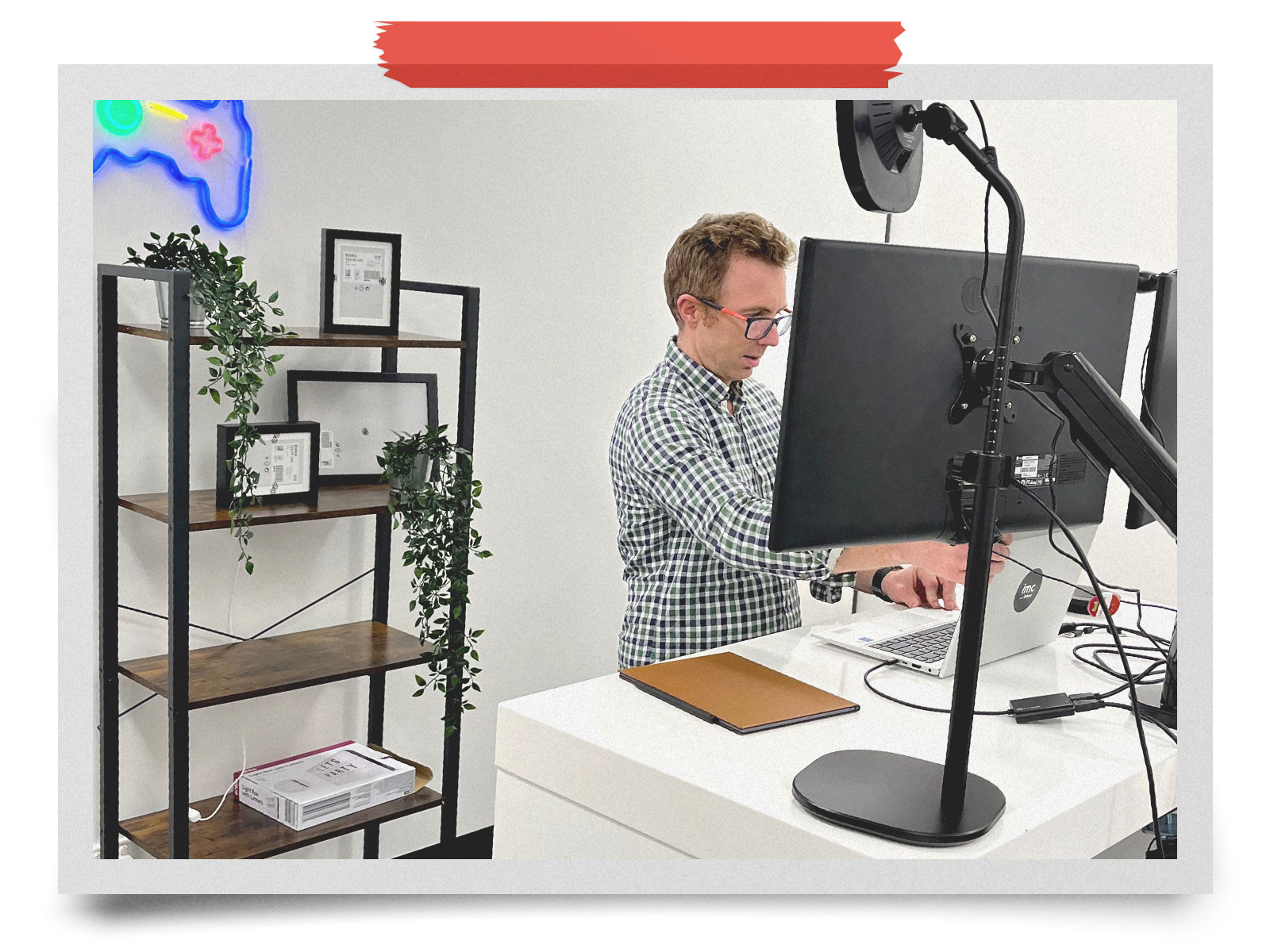
Health awareness: imc Cares
Our transformation to New Work also gave rise to our “imc Cares” health awareness initiative. The idea was to offer our employees support whenever they need it and to place a greater overall focus on health. That’s why we introduced a range of new employee benefits, including the voiio and My Seven Steps work-life-balance platforms. These were accompanied by various new initiatives, such as our employee-led health awareness month.

Brand-new: Our workation model
Our latest benefit takes effect immediately and allows employees to work at any location of their choosing outside of the office or their home. This creates greater flexibility around work location and enhances work-life balance. Who wouldn’t want to turn their evenings after work into a real holiday, in a real holiday spot?

Still a long way to go: Looking ahead
Buoyed by the positive energy of the last year, we’re starting 2023 with new goals. But we also want to continue to support and drive our transformation process. The changes introduced need to be consolidated and further developed over the long term. These include the adaptation of our leadership programme and the continued professionalisation and improvement of our operating model. We’ll also be focussing on leadership and coaching in the New Work model. And needless to say, there will be one or two more office makeovers. Exciting times ahead! We’ll keep you posted.
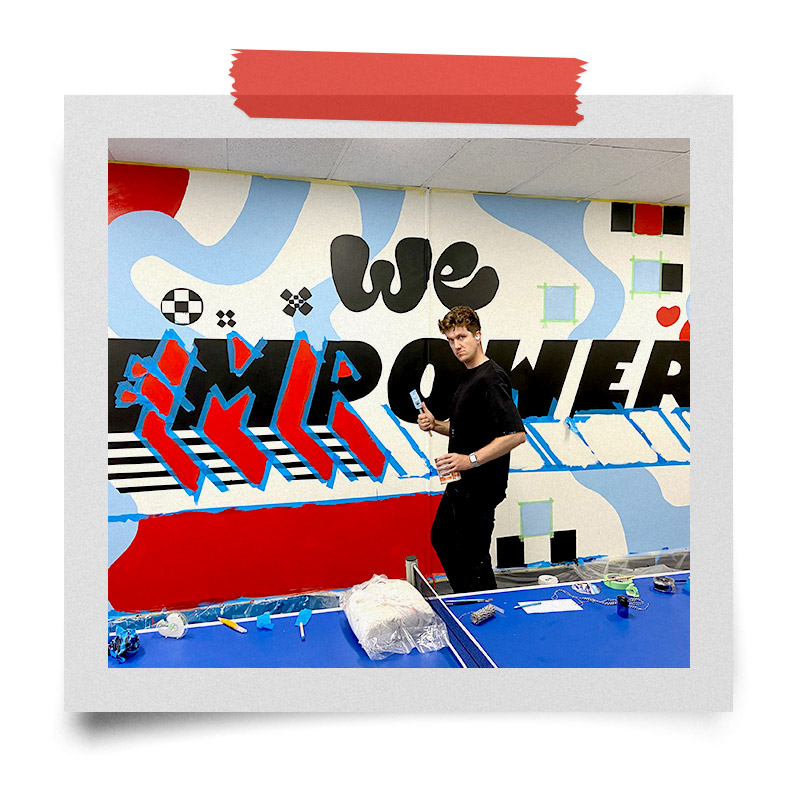
New Work – New Office?
New work needs new offices: That's why we have completely rethought our workspaces and redesigned them in just a few simple steps. Discover our new, modern room concepts.

Why intercultural exchange is crucial for New Work
We take you on a journey on the occasion of our 25th anniversary and show you why positive emotions, personal encounters and intercultural exchange are crucial for New Work.

Contact person
I' ve been working as a permanent member of the imc Marketing & Communication Team since 2021. The mix of creative content creation, social media and online marketing activities excites me the most about my job.
My goal is to inspire people with creative and innovative content and to make the imc brand more tangible.
My passion besides my job? Travelling a lot and discovering the world. I am always happy to receive feedback or suggestions at [email protected]!
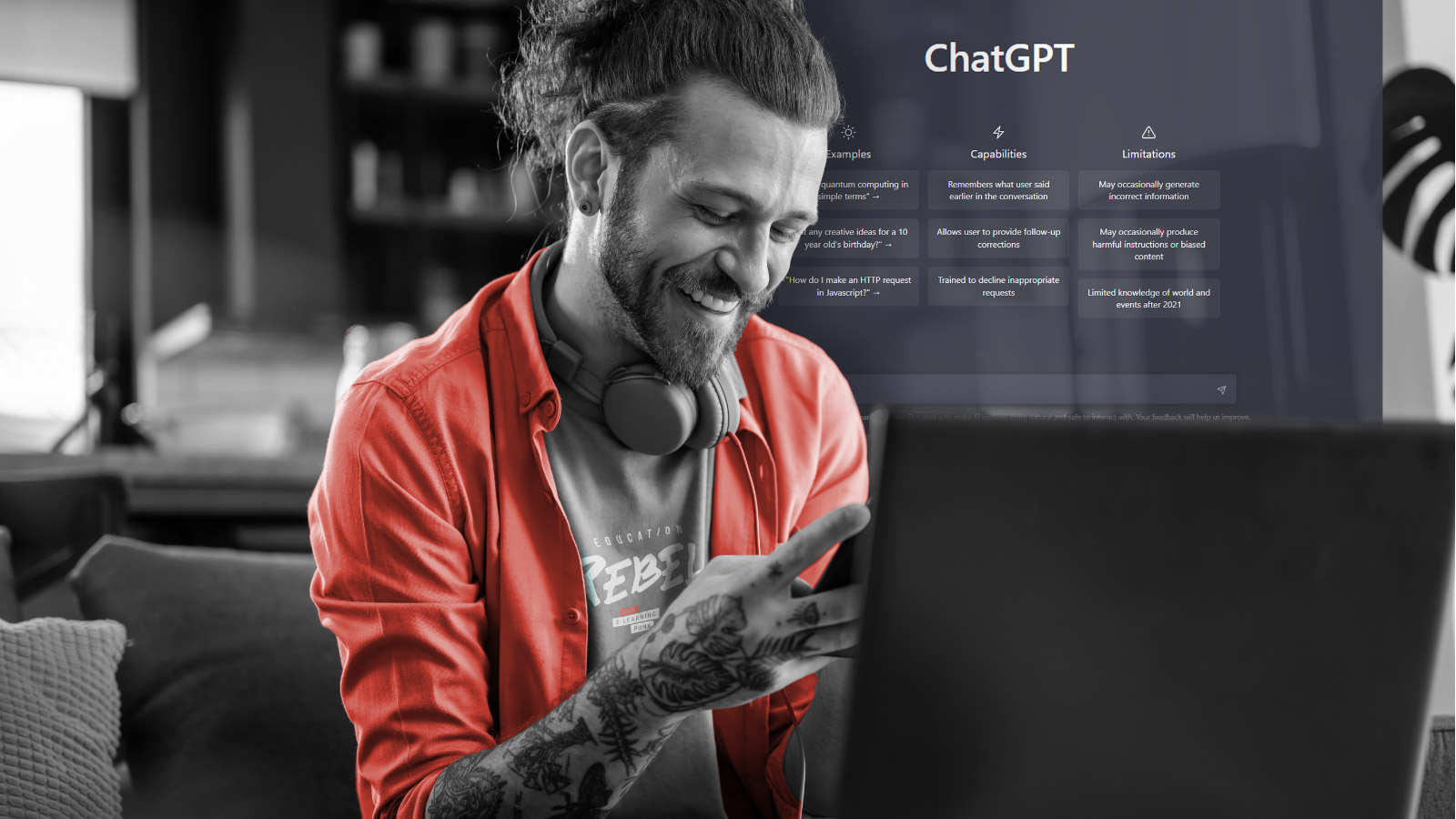
Hype or future: Will ChatGPT revolutionise corporate learning?
AI and chatbots have the potential to transform employee training and development – Our experts check out the possibilities
ChatGPT is a chatbot powered by artificial intelligence (AI). “GPT” stands for “Generative Pretrained Transformer” – meaning the chatbot has been trained up on countless texts. ChatGPT can write content, evaluate compositions, translate, and write screenplays, job applications, emails, entire essays and even song lyrics.
Interacting with ChatGPT is as simple as typing an instruction into its chat window. So that’s what I did:
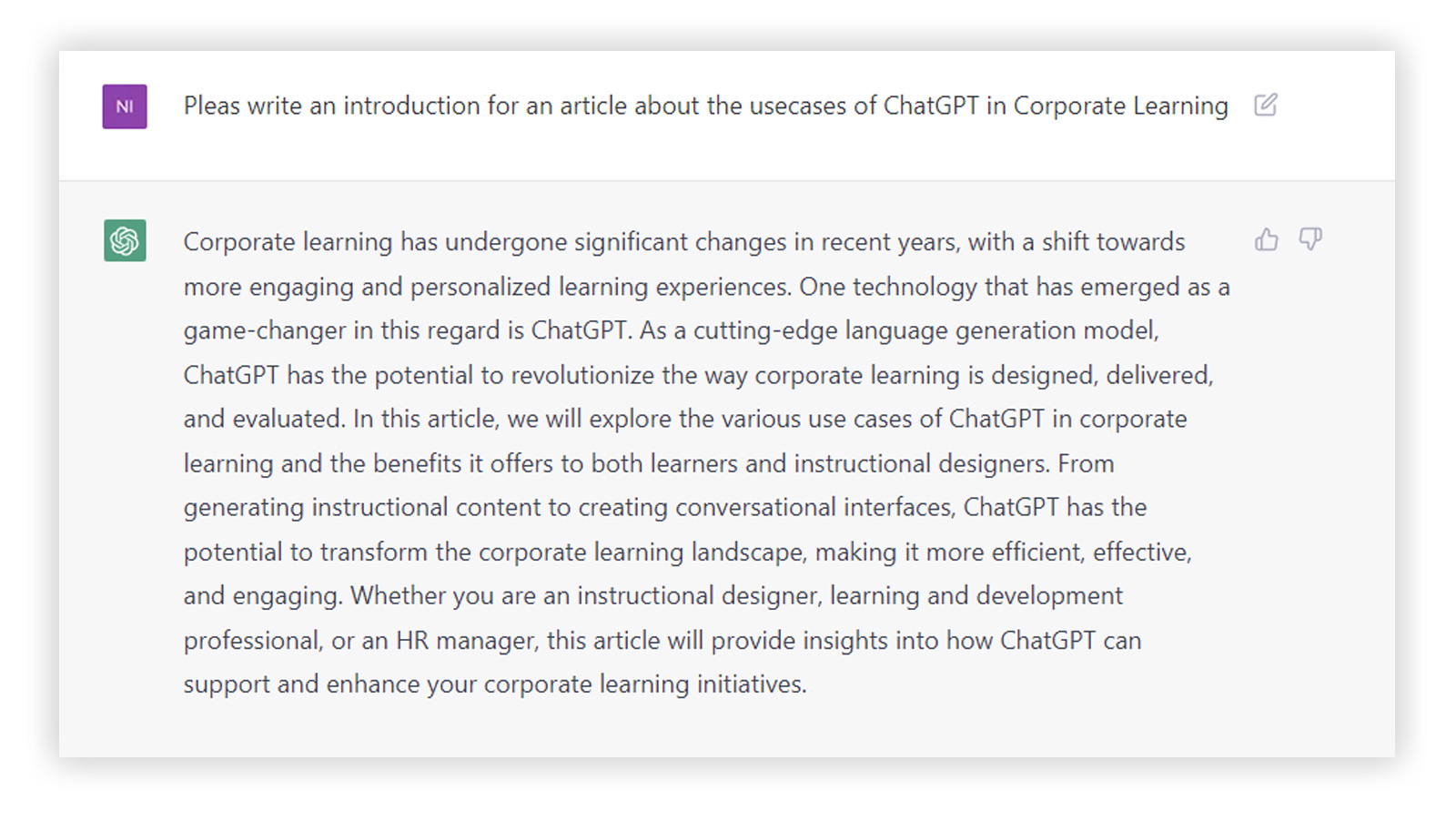
So far, so good. I probably would have put it differently myself, but it’s certainly not wrong. ChatGPT has many potential applications, that’s for sure. But how exactly might we use it in corporate learning and to create training content? I teamed up with an expert to take a closer look.

Diving right in: Making friends with ChatGPT
Faced with the unknown, most people are initially defensive and sceptical. That’s certainly true with new technology. Twenty years ago, we were up in arms about Google, but now we wonder how we ever lived without it.
All the more reason, then, for Arne Benoist to put ChatGPT through its paces. “I was very keen to try ChatGPT for myself – and I was surprised how well it works,” he says.

Arne Benoist, Instructional Designer at imc
Instructional designers convert material and topics into learning content and didactic concepts. They select the learning formats to match the target group, learning goals and corporate objectives. And finally, they create learning environments to make it all happen.
To test the AI, the instructional designer used an old training project that had already been completed. “The tasks I gave ChatGPT were repeats of ones I’d completed myself when I designed the training.”
Summarising long texts:
ChatGPT does a very good job here. It can trim long, complex texts down to any word count and unpack jargon, producing short, easy-to-understand-prose.
Translating:
Here, ChatGPT is similar to DeepL, except that you can specify style. For instance, you can tell it to translate into simple or age-appropriate English.
Brainstorming:
Here, ChatGPT can come up with good initial ideas that you can build on in the later design process.
Arne Benoist did, of course, encounter a few limitations. “For summaries and translations, we can only use public domain content, as OpenAI is an open, online platform. You should never upload company data or confidential information. Currently that would fall foul of most companies’ data protection and privacy rules.”

But: Can ChatGPT creatively design training content?
Designing modern e-learning content is an intensely creative process. It seems strange to think a hunk of AI might make a good job of it. So, Arne Benoist gave it a try:
“For many of our designs we use stories, complete with scenarios, characters and plots. Hence, I asked ChatGPT to create a scenario for a web-based training course on cybersecurity. Well, the chatbot did pretty well, actually, but after a few repeat requests I kept getting similar scenarios. I’m sure I could have got better drafts if I’d fiddled around a bit more and given more specific instructions. But the first stories were too smooth and lacking in dramatic tension for my liking.”

While ChatGPT is thorough and produces solid texts, it appears to output an average of all the knowledge at its disposal. Consequently, for creative work, we’ll be needing the brains and experience of our human experts for a while yet. (Note from author: Phew!)
Still some way off: ChatGPT integration into training courses
Learning with chatbots and IT-powered applications is already a thing in many areas of corporate learning, including with imc Express. But integration of ChatGPT itself? Arne Benoist thinks that’s still some way off. “In most cases we’re working with highly detailed, specific content. So, to use AI in our training courses, we’d have to build the AI ourselves – so we could control it. I’m referring here mainly to data protection, but also to verifying sources.”
Nevertheless, Arne Benoist will be keeping a very close eye on ChatGPT and similar developments. “I’m very much aware ChatGPT is the start of something big, and it has quickly garnered a lot of fans. But I think we still have a way to go before it will truly revolutionize employee training and development. While I can imagine integrating ChatGPT or similar applications in the future, we’re not quite there yet for the kinds of projects we look after.”
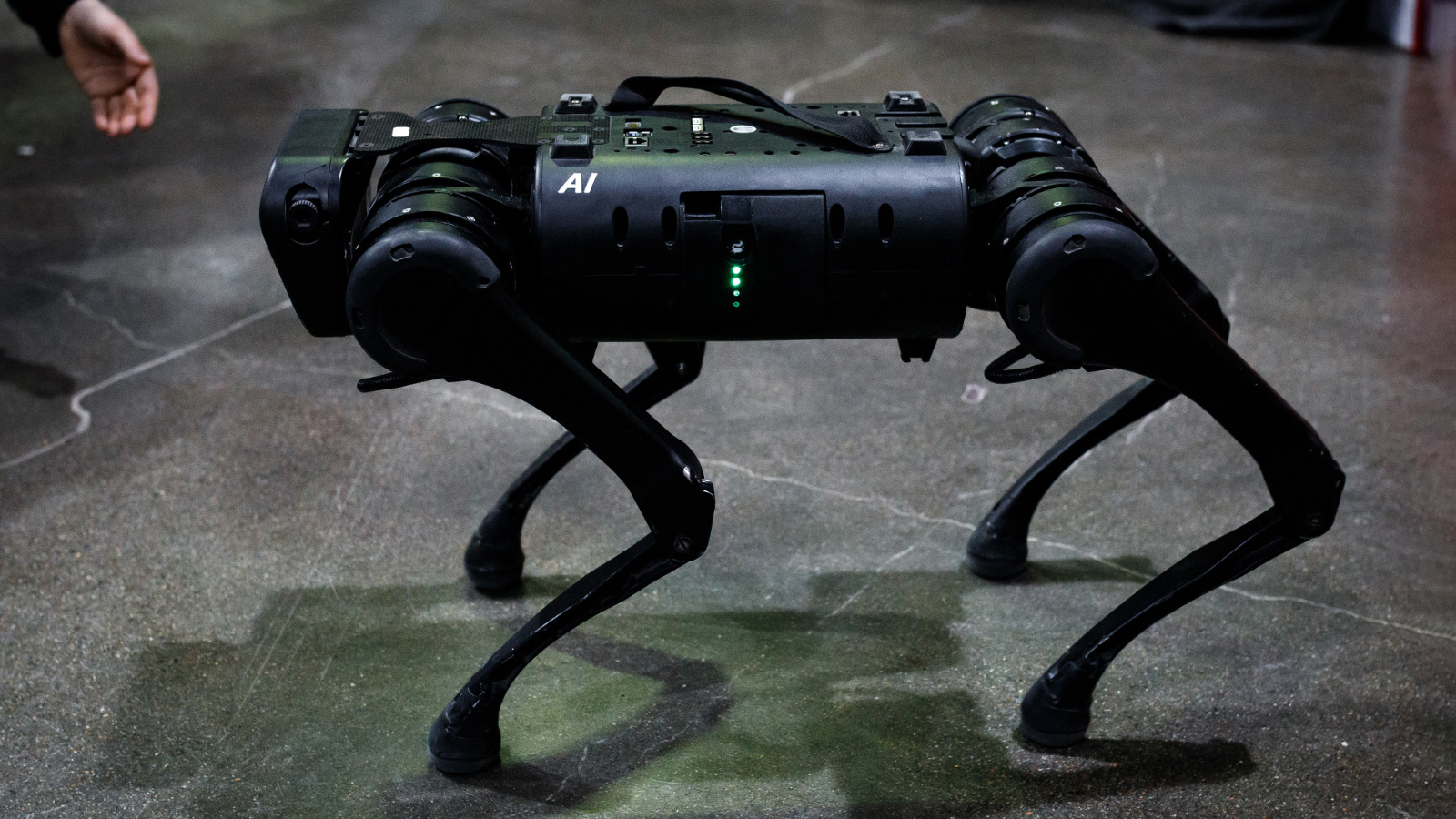
Big things are happening
ChatGPT is certainly not short of ideas on how it can enrich corporate learning:
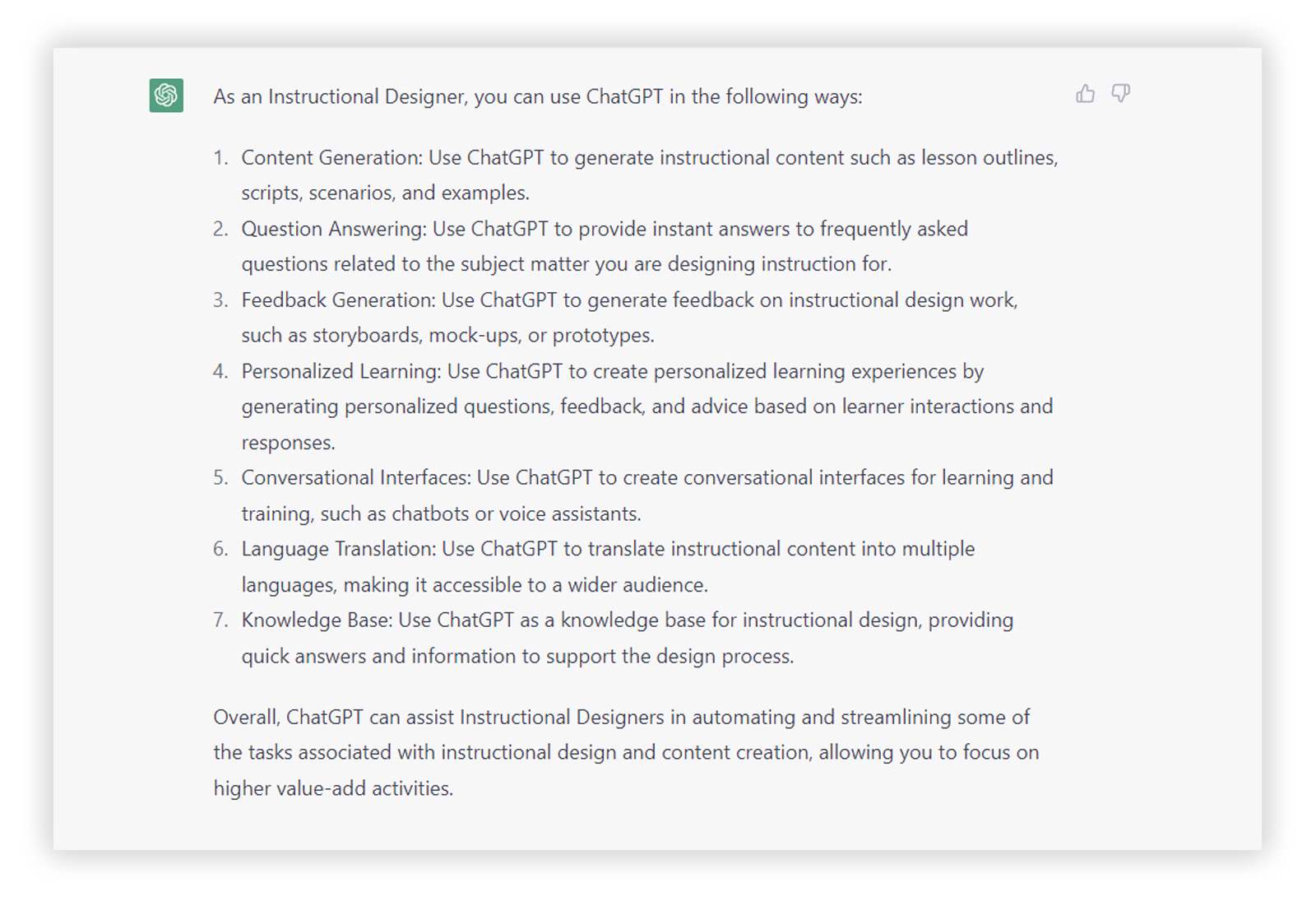
You never know. As Arne Benoist says: “Perhaps we’ll read this article again in a year’s time and laugh at how it has all turned out differently to how we thought.” OK, it’s a date! Let’s check in again in January 2024 and see how far ChatGPT and AI have come.

Can Germany afford its current AI scepticism?
Artificial intelligence (AI) is often viewed sceptically in Germany, but often without justification. In this interview with Kristian Schalter, we talk about how future technologies will change our working world.

AI in Corporate Learning
There are many fears about the topic of artificial intelligence (AI). But especially in corporate learning, AI can be a great help.

Contact person
I joined the imc newsroom team in 2021. As a journalist my heart beats for content and storytelling.
I’m excited to figure out how e-learing and digitization affect the future of work. My task is to create content to talk about and I’m always looking for trends.
Privately I love to travel and eat Tapas.
Topics: E-Learning Trends, Corporate Social Responsibility, Press and Influencer Relations

Development Paths: Moving Beyond Learning Paths
Learning paths have been part of corporate learning for a while, but they’re not being used to their full potential. Learning paths offer more than just a way of providing short-term training for employees. They can be an absolute game changer in the fight to overcome skills shortages.

Greater potential than you might think: Learning paths in LMS
Used correctly, with proper planning and linked to job profiles, learning paths can be a valuable tool for long-term, targeted employee development. Some companies are already aware of the value of learning paths in their bid to overcome skills shortages. They systematically foster lifelong learning and are using them to good effect through their learning management systems (LMS).
This is possible because learning paths are core parts of commonly used learning platforms. Put simply, learning paths are used to map long-term training and professional development plans that span multiple courses. These courses can consist of a very wide range of learning content types, including online courses, face-to-face training, and even periods of blended learning. And often there are dependencies between the individual courses: the learner can’t book Course B until they have successfully completed Course A or met some other prerequisites.
Learning sequence and dependencies within learning paths
Applying these sorts of rules regarding the logical order of learning steps gives rise to various learning concepts. For example, you can create open learning concepts with freely selectable module sequences so the learner can choose the order in which they progress through the modules. Alternatively, you can create closed scenarios in which the sequencing of modules is fixed.
Moreover – and this is where it gets interesting – you can set up these scenarios either as content-based or level-based learning paths. Interesting because this is the point where learning paths become true development paths.
Leveraging content-based learning paths for more structure and better learning experiences
Content-based learning paths are the classic solution and are found in most learning platforms. You can use them to provide and track structured learning content over longer time frames. Take, for example, a six-month onboarding programme in which the participants are required to complete a series of diverse courses.
In case a new hire is assigned to a certain group – say, Sales – in the LMS, they can automatically be signed up for the onboarding programme for that group (in this case “Sales”).
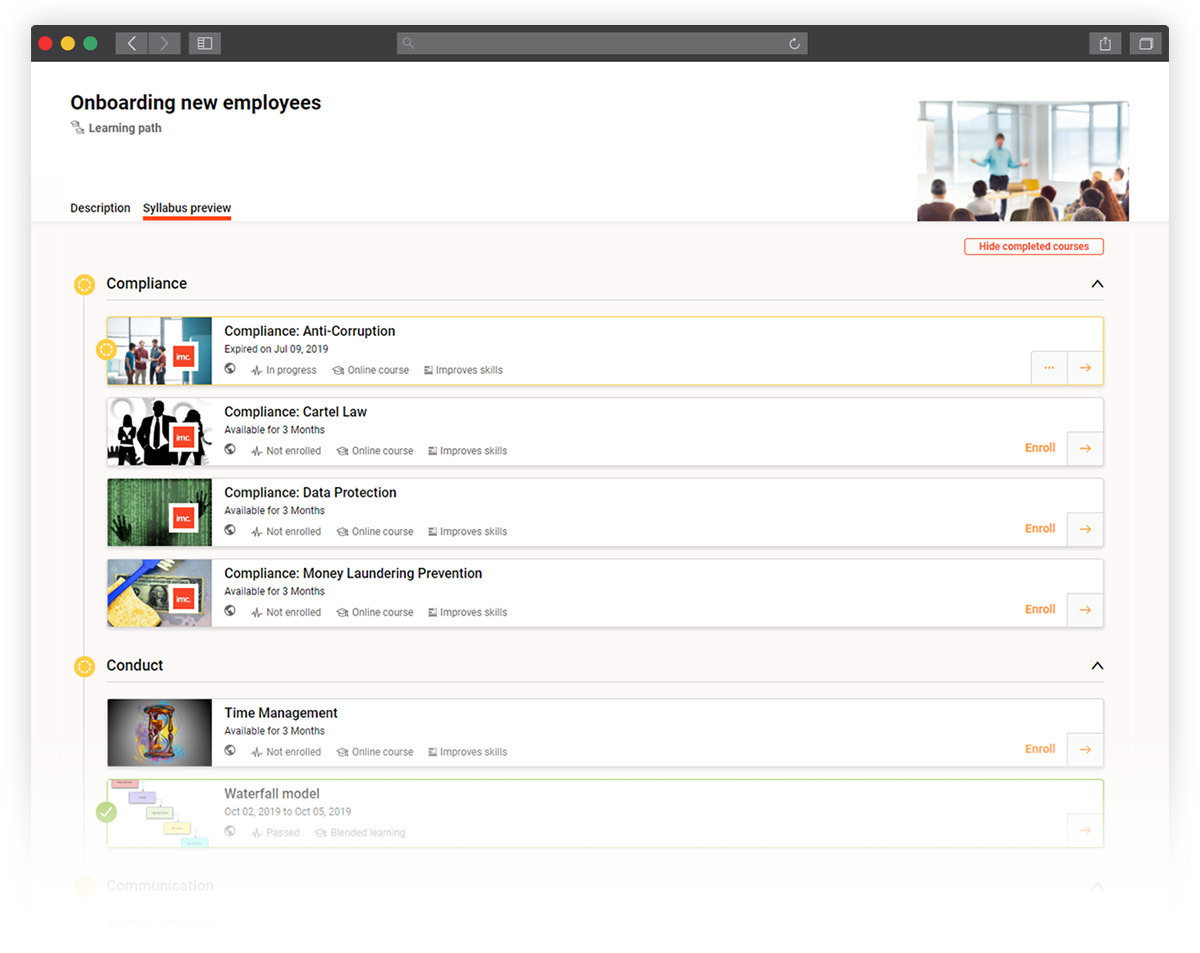
Depending on how the learning path is configured, the new employee is then required to take a test. Depending on the results, they are either allowed to proceed directly to certain modules or required to complete the entire learning path. The learner can in most cases work through the modules in any order they like and can book things like face-to-face training themselves.
In many cases, successful completion of the learning path is conditional on taking a test or passing an assessment interview. Once the learning path has been successfully completed, our learner automatically receives a certificate, which is automatically stored in the system.
Learning paths of this type are a relatively simple way of structuring learning content or courses and are standard in commonly used learning management systems.
Level-based learning paths and recertification
Level-based learning paths resemble content-based ones at first glance but are more sophisticated and offer a lot more options. They consist of three levels, each building on the previous one, and are directly linked to the learner’s skill and role profiles.

This opens up a wealth of applications, as imc business consultant Tobias Sommer explains: “Daimler Global Training, with whom we co-created learning paths of this type, uses them in various scenarios, such as helping employees to meet the requirements of certain job profiles.
Other clients use level-based learning paths for recertification. Recertification means that an employee must regularly complete prescribed professional development courses within the learning path in order to maintain their status as a specialist in a certain area.
If the employee does not complete the level by the specified deadline, they lose their specialist status. But if they do complete it, they can use that as proof that they have undertaken the latest training – for a particular software, for example. In this way, Daimler is actively integrating lifelong learning into the everyday routines of its employees while at the same time undertaking ongoing quality assurance.”
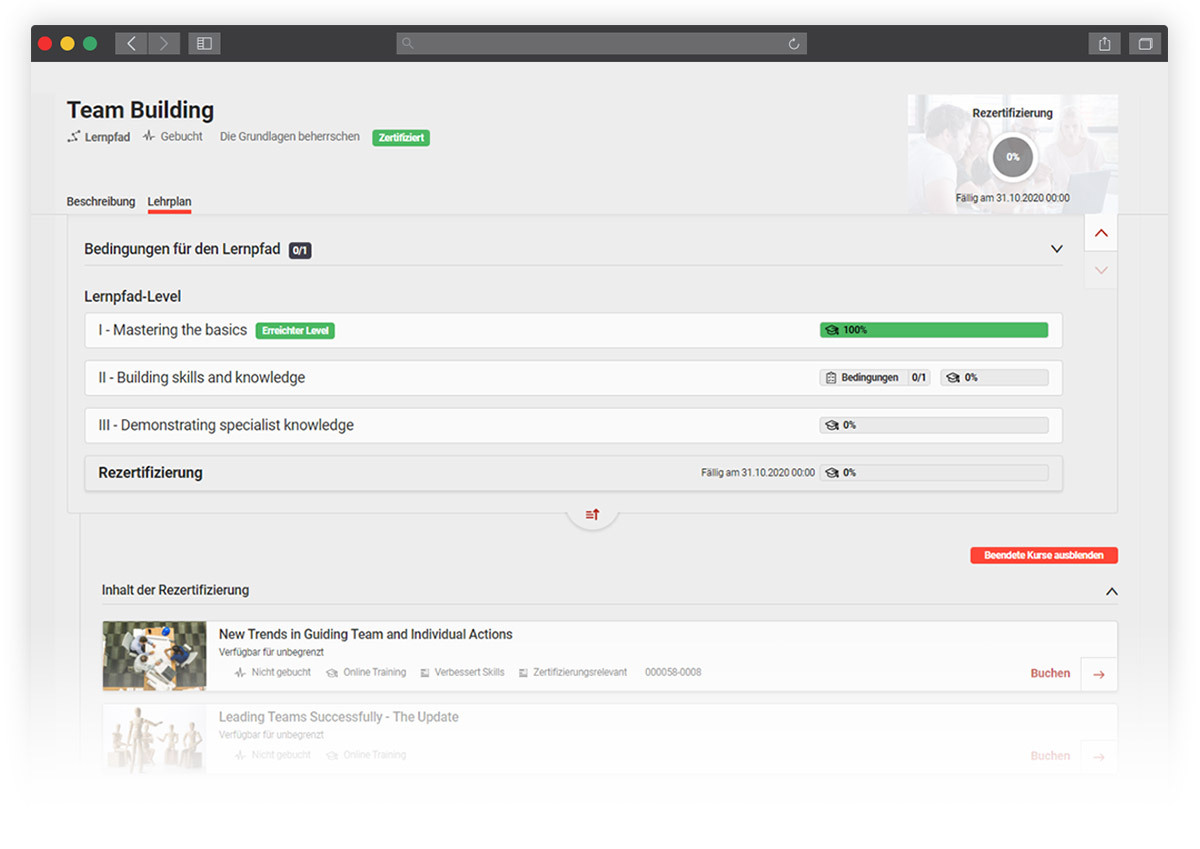
Direct integration of certificates and new jobs
Other options for getting the most out of level-based learning paths include using them in conjunction with job advertisements, certificates, and clearances to access certain documents. In other words, certain prerequisites and access restrictions can be tied to pre-defined levels.
Take, for example, a learner who is in learning path two of three. Before the learner can graduate from their current learning path and hence gain access to sensitive documents, their supervisor must confirm in the system that they have acquired all the necessary knowledge. Only then, and after passing a final test, will the learner be authorised to access the documents in question. You can also take the same approach with job profiles: employees are blocked from seeing certain job advertisements until they have acquired the skills needed for the job in question.
Then there’s the certificate use case, as Sommer explains: “The system can also be set up to generate certificates automatically so that, on completion of learning requirements, learners automatically receive certificates which are then also automatically stored in their profiles. This saves time by eliminating manual up- and downloads and HR involvement. Learners can receive certificates on completion of the entire learning path or, in the case of level-based learning paths, on completion of each level as well.”

Using development paths instead of learning paths: What’s the benefit?
As we have seen, the potential of learning paths is immense. Tobias Sommer: “Used consistently, level-based learning paths are more like development paths that can be used to take professional development – or even the push to fill skills shortages – to a whole new level.
If I know exactly what qualifications my employees have and consistently provide professional development, I will have the agility, for example, to rapidly fill positions from within the company. I can simply look up which employees might be suitable based on their qualifications and save myself any unnecessary searching.
And that’s why I think this function still has enormous potential, and why I’d like to see more companies recognising that and taking advantage of it.”

Diary of an LMS
If an LMS wrote a diary - what would it say?
We thought about that and share some tips for LMS professionals, told a little differently...

Informal learning: Everyday hero of work
“Formal learning is like riding a bus. Informal learning is more like cycling.” We explain what this means and share some key facts and recomemndations
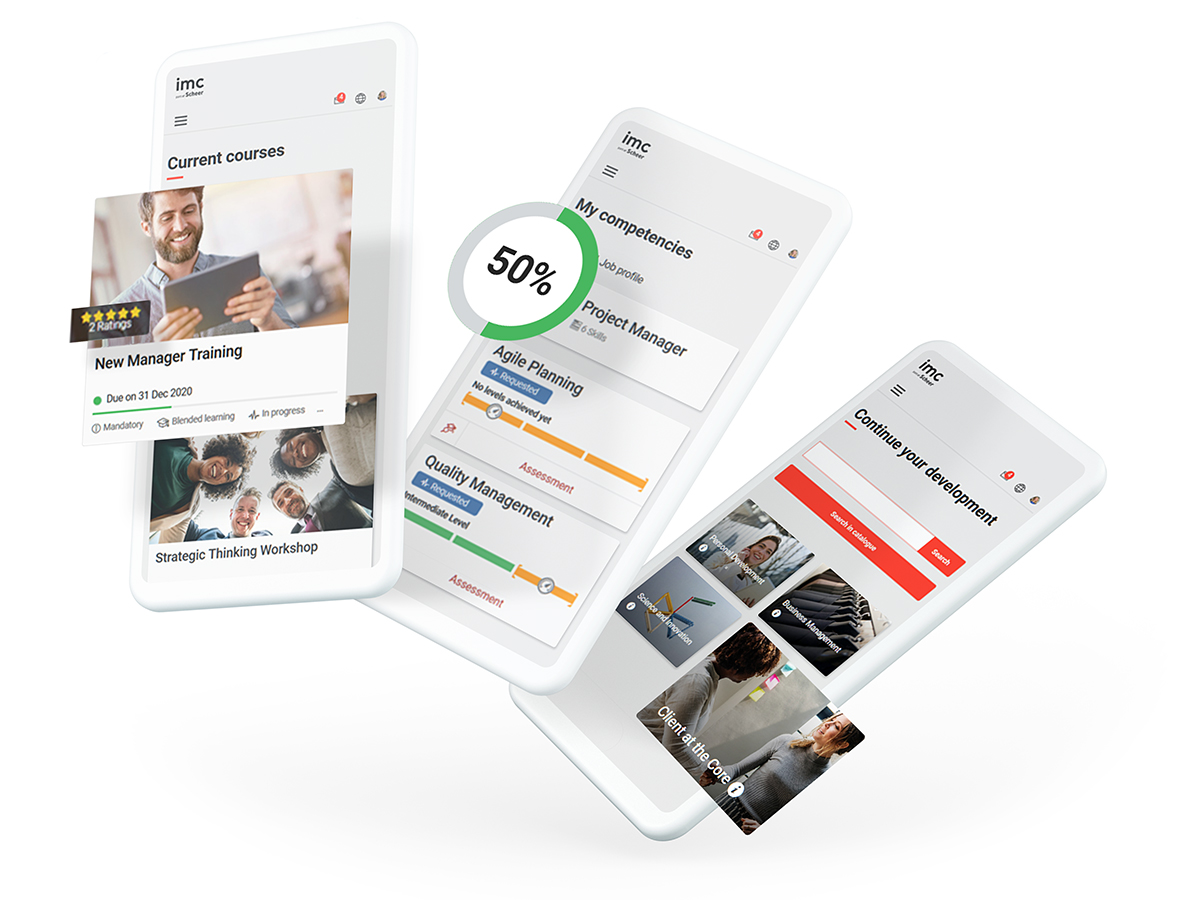
More about our LMS
If you would like to learn more about imc's Learning Management, check here for more information.

Contact person
I have been working in the Marketing & Communication Team at imc since March 2019.
Communication, creative content and social media are my passion. "KISS - Keep it short and simple" is my credo.
To explain complex content in an understandable way and thus make the topic of e-Learning accessible to everyone is an exciting challenge every day.
Privately I love to read, play poker and travel a lot.
I am always happy to receive feedback or suggestions.

imc D&I crew looks back at 2022
In-Person and Remote: Members of the imc Diversity Movement Gather to Celebrate Successful Year
Diversity. It’s hard to think of a word that’s been more polarising this year. Heidi Klum used it in practically every episode of “Germany’s Next Top Model”, positioning herself as pro-diversity in the modelling industry. The reaction may not have been universally positive, but at least the issue was on the agenda.
And now sports fans, too, have been forced to think about diversity, thanks to it being a constant feature of the coverage of the recent Football World Cup in Qatar. Many found the focus on diversity unwelcome, but then again, many also felt the matter wasn’t receiving nearly enough attention. One question came up again and again: Does diversity even have a place in professional sport? Obviously, that’s not something we at imc can provide a final response to, but what we can say is that diversity and inclusion have become even more important to us this year.

In order to establish diversity and inclusion as broadly as possible in our organisation, we launched a D&I programme – a programme organised by our employees, for our employees. To ensure everyone can find what they are looking for, the programme is structured into three main elements: EmpowHER, a programme to connect and empower women at imc; the Cultural Diversity programme; and Diversity of Interests, a programme to celebrate the personal strengths of our employees and the interests that drive and inspire them.
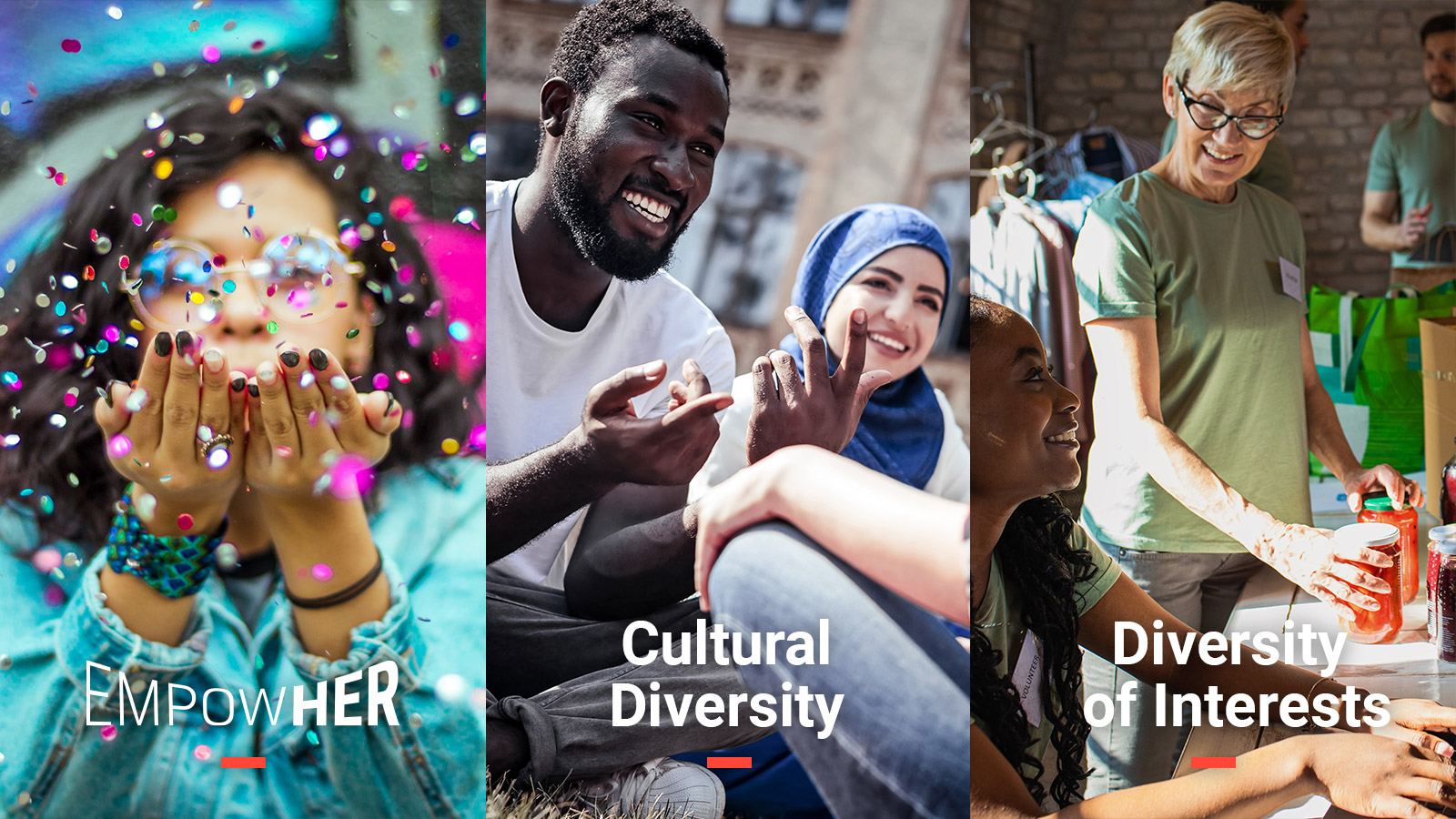
The three pillars of the D&I movement at imc
End-of-year debrief and campaign recap
With the year drawing to a close, we wanted to get everyone around a (virtual) table one last time to reflect on the successful year that was and look ahead to the year to come. And that’s precisely what we did. The D&I crew’s official end-of-year debrief was held in virtual form in December. The attendees reflected on the highlights of 2022 and then got down to the exciting business of what would be happening next. The short story here is that many of the D&I initiatives were so well received at imc that they will be continued in 2023.
The InspireHER tandem programme will be back next year, helping women within the imc organisation to network, share experiences, ideas and tips, and foster personal growth through mutual reflection and feedback.

Next year will also see the return of the “Get to know more about ...” series of cultural diversity talks on ways of overcoming various stereotypes here at imc. The organising team has sessions planned for each of our locations.
The “Diversity of Interests” team is also keen to step things up next year. They will be organizing barcamps where employees from all locations will be encouraged to talk about and celebrate their respective personal qualities, knowledge, interests and talents – including personal interests outside of work, such as volunteer work, social engagement, club memberships and unusual hobbies.
The official recap event was followed by a shared lunch at each of imc’s offices – the perfect way for the D&I crew to bring their year to a close.

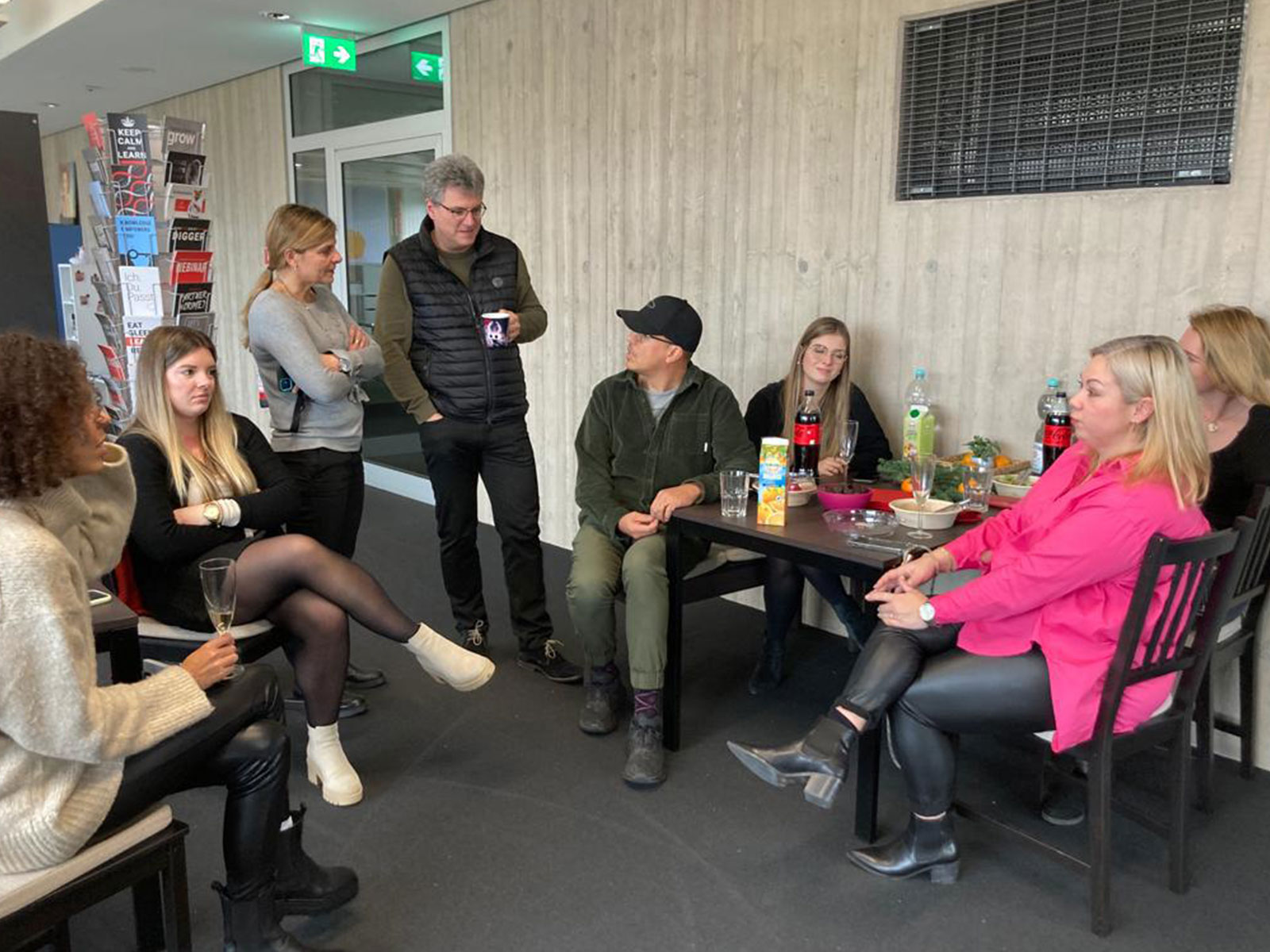
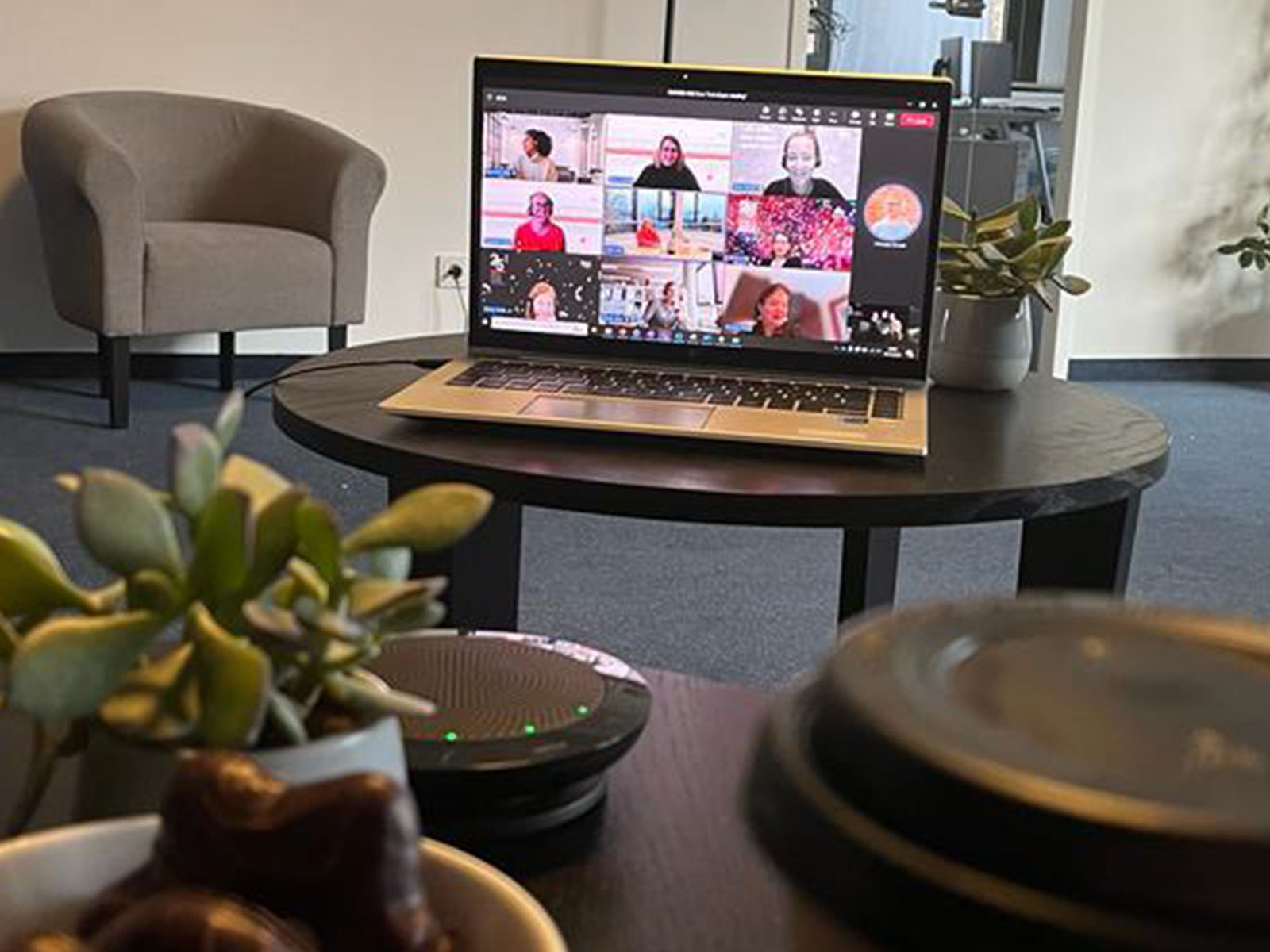








Kerstin Steffen, Director Brand Strategy, imc
“Our end-of-year event was truly inspiring in every respect,” says Kerstin Steffen, one of the founding members of the D&I crew. “It’s so pleasing to see that our diversity movement is growing steadily and reaching more and more employees. We’ve already achieved so much, so we’re still totally fired up to keep going. This positive spirit shone through at our get-together, and we can’t wait to see what next year brings.”

Diversity and Inclusion Isn’t Just for Diversity Week and Pride Month
This year, the international "Diversity and Inclusion Day" fell on Saturday, May 21, 2022. Since we knew that it would be difficult to reach our colleagues on Saturdays, we simply placed the entire week until then under the sign of diversity and inclusion at imc.

Diversity in e-learning content
Diversity in e-learning is clearly growing in importance. So, in this article, we have put together a summary of key recommendations for companies seeking to incorporate diversity into their learning experience.
Contact
I joined the imc newsroom team in 2021. As a journalist my heart beats for content and storytelling.
I’m excited to figure out how e-learing and digitization affect the future of work. My task is to create content to talk about and I’m always looking for trends.
Privately I love to travel and eat Tapas.
Topics: E-Learning Trends, Corporate Social Responsibility, Press and Influencer Relations

